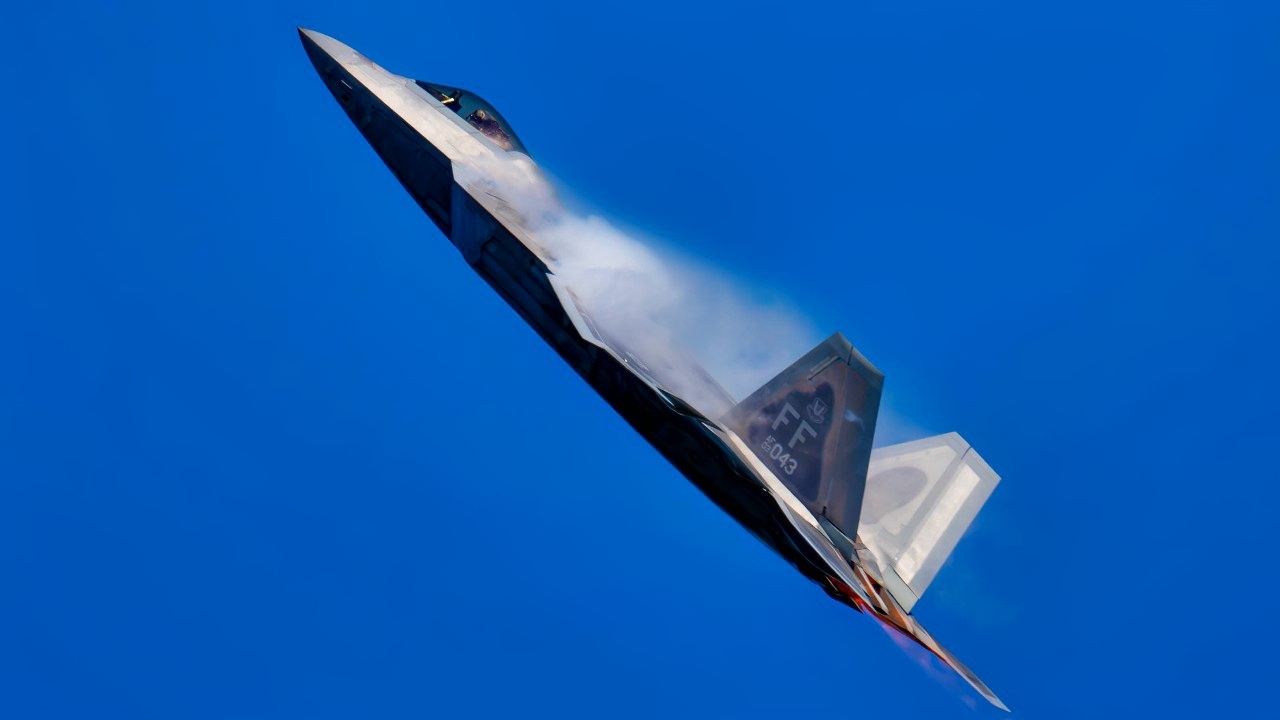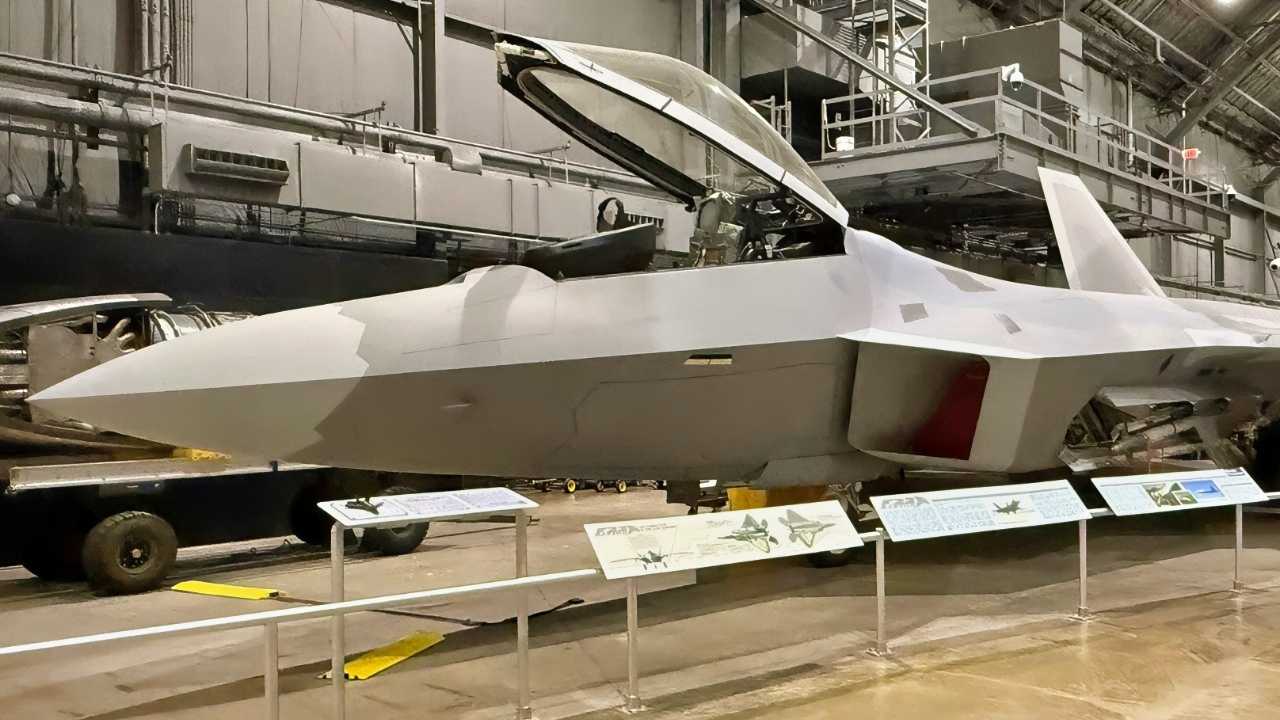Key Points and Summary – Carefully managed reveals from China strongly suggest its carrier-capable J-35 stealth fighter has entered low-rate initial production and may already be in service with the PLAN.
-The “accidental” appearance of multiple J-35s in a state-run CCTV broadcast, followed by official-looking photos of jets with production-style tail numbers and naval aviator markings, points to a deliberate messaging campaign.

USAF Capt. Nick “Laz” Le Tourneau, F-22 Raptor Aerial Demonstration Team pilot and commander, performs a practice demonstration at Joint-Base Langley-Eustis, 17 March, 2025. Laz is the only F-22 Raptor pilot in the world certified to fly the demonstration. (U.S. Air Force photo by Staff Sgt. Michael Bowman)
-While the possibility of a sophisticated disinformation effort cannot be entirely dismissed, the growing body of evidence, including a massive new production facility, indicates that China’s F-35 competitor is on a steady path to full operational capability.
China’s J-35 Stealth Fighter Might Have Its Moment Now
Recent footage and reports from Chinese state media may suggest that China’s Shenyang J-35 fifth-generation carrier-based fighter may have entered into limited production.
If true, this means that development on China’s most recent fifth-gen fighter may be further along than previously anticipated and that it may soon enter into active service.
The introduction of the J-35 into service with the PLAN would significantly increase China’s ability to project power across its oceans and ensure a solid defense against American air power in the region.
The J-35 in Production Already?
Several days ago, new footage of the J-35 was spread across Chinese internet sites which appears to be official footage from the PLAN. The images show two J-35s flying side-by-side in close formation. Analysts quickly noticed the construction numbers on the fighters (0011 and 0012 respectively) as well as the insignias on the tails which seems to indicate that the J-35 has indeed entered into low-rate initial production (LRIP).
In addition to the markings, analysts noticed other more subtle differences between the newly shown J-35s and the prototype demonstrated last year.
Based on the thrust nozzles, the limited production model seems to be using a different power plant compared to earlier prototypes. Some reports indicated that the J-35 may use the WS-19 turbofan engine whereas the naval variant uses the WS-21 engine. While there is currently no way of telling which engine it uses exactly, the two models do seemingly use different power packs.
Development of the J-35
The J-35 originally began as the FC-31 Gyrfalcon, a prototype stealth fighter that first flew in 2012. Unlike the J-20, which was developed by Chengdu Aircraft Corporation with full state backing, the FC-31 was initially a privately funded project by SAC.
It was designed with the hope of attracting foreign buyers and possibly securing a role within the Chinese military. For several years, the FC-31 remained a demonstrator, undergoing various design changes and test flights without a clear path to production. However, by 2021, a new version of the aircraft emerged, clearly tailored for naval operations.
This updated design featured folding wings, reinforced landing gear, and a catapult launch bar, strong indicators of its intended use aboard aircraft carriers. This version would eventually be designated the J-35.
The J-35 took its first flight on October 29, 2021, and a land-based variant, known as the J-35A, followed in 2023. The J-35A was publicly displayed at the 2024 Zhuhai Air Show, signaling China’s confidence in the aircraft’s readiness and capabilities.
In July 2025, the J-35 officially entered service with the PLAN, with operational units bearing naval insignia and serial numbers. This milestone confirmed the aircraft’s transition from prototype to frontline fighter.
Design and Specs
On the surface, the J-35 shares many design characteristics of the American F-35 but there are a number of differences that separate the two. It is intended to perform both air superiority and strike missions, making it a versatile asset for the Chinese military. The aircraft’s airframe is optimized for stealth, with angular surfaces, radar-absorbing materials, and internal weapons bays that reduce its radar cross-section.

A U.S. Air Force F-35A Lightning II assigned to the 60th Fighter Squadron, flies overhead after conducting a live weapons drop at Camp Shelby, Miss., Oct 25, 2023. During the exercise, pilots tested various munitions including the GBU-12s, GBU-31v1s, and 362 rounds of 25mm Training Munitions from the gun.
The twin tail fins and divergent engine nozzles help minimize its infrared signature, while the folding wings and reinforced undercarriage are tailored for carrier operations.
The J-35 is equipped with advanced avionics and sensor systems. It features an Active Electronically Scanned Array (AESA) radar, which provides high-resolution tracking and targeting capabilities. The aircraft also includes a Distributed Aperture System (DAS) for 360-degree situational awareness, as well as electro-optical targeting systems and infrared search and track (IRST) sensors.
These systems are integrated through data fusion technologies, allowing the pilot to receive a comprehensive picture of the battlespace. Secure datalinks enable the J-35 to operate as part of a networked force, sharing information with other aircraft, ships, and ground units.
In terms of performance, the J-35 is believed to be powered by two WS-13 or upgraded WS-19 engines, although exact specifications remain classified. The aircraft is estimated to reach a maximum speed of Mach 1.8, with a combat radius of approximately 1,200 kilometers and a service ceiling of around 16,000 meters.
It can carry a weapons payload of up to 8,000 kilograms, including air-to-air missiles, precision-guided bombs, and anti-ship missiles. These capabilities make the J-35 a formidable platform for both defensive and offensive operations.
The J-35 is a Big Deal
With the J-35 on the verge of entering operational service, there are a number of implications that must be considered. First, it enhances China’s ability to project air power across key maritime regions, including the South China Sea, East China Sea, and Western Pacific. With its stealth capabilities and advanced sensors, the J-35 provides a credible counter to U.S. F-35B and F-35C operations in the region.

250520-N-TW227-1112 EAST CHINA SEA (May 20, 2025) An F-35B Lightning II fighter aircraft from Marine Fighter Attack Squadron (VMFA) 242, prepares to land on the flight deck of the forward-deployed amphibious assault ship USS America (LHA 6) while conducting flight operations in the East China Sea, May 20. America, lead ship of the America Amphibious Ready Group, is operating in the U.S. 7th Fleet area of operations. U.S. 7th Fleet is the U.S. Navy’s largest forward-deployed numbered fleet, and routinely interacts and operates with allies and partners in preserving a free and open Indo-Pacific region. (U.S. Navy photo by Mass Communication Specialist 3rd Class Kenneth Melseth)
Second, the J-35 marks a major step in the modernization of China’s carrier aviation. It replaces the older, fourth-generation J-15 fighters with a stealth platform capable of operating in contested environments. This shift enables China to conduct more sophisticated and survivable carrier-based operations.
Currently, the J-35 is expected to undergo carrier-based sea trials before it officially enters PLAN service. It will likely be deployed aboard the type 003 Fujian aircraft carrier, which is the latest generation of carriers in service in the Chinese Navy. The J-35’s development also parallels China’s efforts to field sixth-generation fighters, with prototypes already under development by both Shenyang and Chengdu.

F-22A Raptor In Dayton, Ohio, National Security Journal Photo.
About the Author:
Isaac Seitz, a Defense Columnist, graduated from Patrick Henry College’s Strategic Intelligence and National Security program. He has also studied Russian at Middlebury Language Schools and has worked as an intelligence Analyst in the private sector.
More Military
We Almost Touched the F-117 Stealth Fighter











Paul Freed
July 25, 2025 at 10:09 pm
Hmmm. Low rate production of J-35. There are 1200+ F-35s prowling the skies right now. And they are going to be paired with “loyal wingman” drones. Are we supposed to be scared? The F-35 is the most prolific stealth fighter in the world. The J-20 has problems with it’s stealth profile depending on the angle the engaging aircraft comes at it from. Intelligence says that the Chinese believe they’ll have parity with the U.S. this year or early next. Perhaps. But somehow I think there are some Skunkworks toys that might be hiding out there that might burst their bubble. Or Boeing Phantom Works toys.